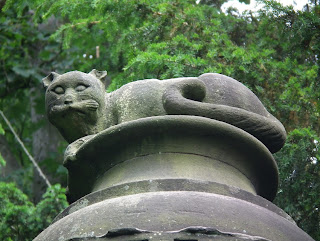Saturday, July 15, 2017
Shugborough, Staffordshire, and more
Retrospective (3): Feline tales
It has been said à propos of social media that, having invented the most sophisticated form of communication yet devised by humankind, we use it for sharing pictures of cats. I offer no apologies, though, for this short selection of cat posts, offered as my third retrospective to celebrate a decade of this blog. These, after all, are architectural cats, and the image of the feline form, used as an embellishment on or near buildings, says something about our fascination with these intriguing, beautiful, and sometimes infuriating creatures.* My handful of posts contains cats from the mid-18th to the late-20th century, but which show artistic influences stretching back thousands of years. And that is proof enough that not just our relationship with cats but also our artistic engagement with them is far, far older than the internet.
A sea-going cat in Staffordshire
A church cat in the Cotswolds
A museum mouser in Hereford
A landmark cat in...Catford
The Egyptian-style cats of Mornington Crescent
A ginger tom in Thaxted.
- - - - -
* The novelist Raymond Chandler referred to his cat Taki as his 'secretary' because whenever Chandler tried to write anything, the creature would drape itself over his notepad or sit on the copy he wanted to revise. I have had this experience with a cat myself and have found it beguiling and maddening by turns.
Subscribe to:
Post Comments (Atom)




3 comments:
The story regarding the Shugborough cat monument is interesting:
http://www.cheriesplace.me.uk/blog/index.php/2013/02/21/the-cats-monument/
The story regarding the Shugborough cat monument is interesting:
http://www.cheriesplace.me.uk/blog/index.php/2013/02/21/the-cats-monument/
I suppose there's an irony in the fact that Shugborough stands so far from the sea. Given the homing instinct in cats, would it have wanted, if released, to go back round the world again in the reverse direction? Or would a gentle stroke and a good plateful of the 18th century equivalent of "Whiskers" have quickly reconciled it to its latest geographical location?
Post a Comment